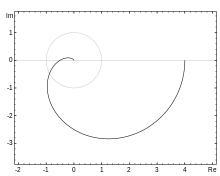奈奎斯特图

奈奎斯特图(英语:Nyquist plot)是对于一个连续时间的线性非时变系统,将其频率响应的增益及相位以极座标的方式在复平面中绘出,常在控制系统或信号处理中使用,可以用来判断一个有反馈的系统是否稳定。奈奎斯特图的命名是来自贝尔实验室的电子工程师哈里·奈奎斯特(Harry Nyquist)。
奈奎斯特图上每一点都是对应一特定频率下的频率响应,该点相对于原点的角度表示相位,而和原点之间的距离表示增益,因此奈奎斯特图将振幅及相位的波德图综合在一张图中。
一般的系统有低通滤波器的特性,高频时的频率响应会衰减,增益降低,因此在奈奎斯特图中会出现在较靠近原点的区域。
用途
[编辑]闭环负反馈系统的稳定性评估可以由开环系统(同一个系统,但不考虑其反馈回路)的奈奎斯特图,配合奈奎斯特稳定判据判断其稳定性。此方法甚至可以用在有延迟的系统,或是传递函数不是有理函数的系统,这些系统用其他方法都很难分析。可以借由图线围绕的次数及开环传递函数右半平面的极点数量来判断稳定性。增益裕度可以用图形越过实轴的数值(幅值裕度),或图线穿过单位圆时的相位(相角裕度)来计算。
奈奎斯特图可以提供一些有关传递函数的信息。例如曲线进入原点时的角度可以计算极点个数和零点个数的差[1]。
当手绘奈奎斯特图时,可以画出图形的外观,但座标轴部分有些调整,以显示一些重要部分的信息。当用计算机绘图时,需要包括所有有关的频率范围,因此频率可能会用对数的方式增加,以包括大的频率范围。
相关条目
[编辑]参考文献
[编辑]- ^ Nyquist Plots. [2013-09-14]. (原始内容存档于2008-09-30).
外部链接
[编辑]- Applets with modifiable parameters(页面存档备份,存于互联网档案馆)
- EIS Spectrum Analyser - a freeware program for analysis and simulation of impedance spectra(页面存档备份,存于互联网档案馆)
| ||||||||||||||||||||||||||||||||
Text is available under the CC BY-SA 4.0 license; additional terms may apply.
Images, videos and audio are available under their respective licenses.

